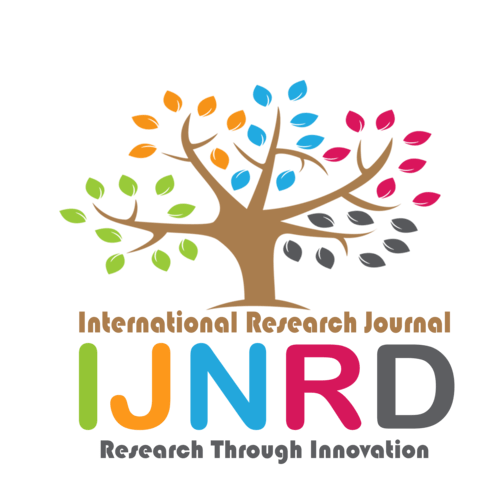|
|||||||||||||||

|
INTERNATIONAL JOURNAL OF NOVEL RESEARCH AND DEVELOPMENT International Peer Reviewed & Refereed Journals, Open Access Journal ISSN Approved Journal No: 2456-4184 | Impact factor: 8.76 | ESTD Year: 2016 Scholarly open access journals, Peer-reviewed, and Refereed Journals, Impact factor 8.76 (Calculate by google scholar and Semantic Scholar | AI-Powered Research Tool) , Multidisciplinary, Monthly, Indexing in all major database & Metadata, Citation Generator, Digital Object Identifier(DOI) |
||||||||||||||
Issue: April 2024
Volume 9 | Issue 4
Review Result and Publication of Paper within : 2-3 days
Click Here For more DetailsFor Authors
Forms / Download
Published Issue Details
Editorial Board
Other IMP Links
Facts & Figure
Impact Factor : 8.76
Issue per Year : 12
Volume Published : 9
Issue Published : 95
Article Submitted :
Article Published :
Total Authors :
Total Reviewer :
Total Countries :
Indexing Partner
Join RMS/Earn 300
Licence
This work is licensed under a Creative Commons Attribution-NonCommercial 4.0 International License







|
Published Paper Details
|
|
| Paper Title: | “LAW RELATING TO LIMITED LIABILITY PARTNERSHIP AND ITS IMPACT ON BUSINESS ENVIRONMENT IN INDIA : AN ANALYTICAL STUDY” |
| Authors Name: | SUBHAM SHARMA |
| Download E-Certificate: | Download |
| Author Reg. ID: |
IJNRD_199680
|
| Published Paper Id: | IJNRD2306322 |
| Published In: | Volume 8 Issue 6, June-2023 |
| DOI: | |
| Abstract: | “LAW RELATING TO LIMITED LIABILITY PARTNERSHIP AND ITS IMPACT ON BUSINESS ENVIRONMENT IN INDIA : AN ANALYTICAL STUDY” The directors of such (joint-stock) companies, however, being the managers rather of other people’s money than of their own, it cannot well be expected. that they should watch over it with the same anxious vigilance with which the partners in a private copartnery frequently watch over their own.... Negligence and profusion, therefore, must always prevail, more or less, in the management of the affairs of such a company. Although the modern champion of this corporate efficiency aspect of agency cost is Michael Cole Jensen of the Harvard Business School, the essence of this concept was highlighted as early as in 1776. when Adam Smith wrote ‘An Inquiry into the Nature and Causes of the Wealth of Nations . However, it is analyzed that in case of the LLP the role of directors is done away rather the concept of designated partners is introduced thereby, which provides the reins of the management of the LLP to the partners. India being a member of the extended global economic village has not remained untouched with the meltdown and economic recession. While 0-20 summit has been held to evolve policies for walking out of shadow of economic recession, Indian Inc. apprehends further slowdown and losses in the running of the industries. There is a concern that in the upcoming times, there would be a reporting of various industries being on the verge of insolvency or turning insolvent and a timely action is to be taken to avoid loss of production, loss to Government revenue and employment as also the locking up of invertible funds of banks and financial institutions. In the present day context, it is analyzed that while the losses in the industry are escalating and the government is taking steps to counter the economic downturn, the LLP legislation will play a pivotal role to improve the business environment and Indian economy as such. The various avenues of opting for the LLP and its impact on business environment are discussed at length in this Chapter. 6.2 The Limited Liability Partnership: A Risk Management Tool The Limited liability encourages greater boldness and risk-taking among the business community, so that new avenues to increasing commerce are explored. In the globalised economy, the need to enhance the competitiveness of business and to build, or nurture, a culture of enterprise and entrepreneurship is duly recognized and the LLP is an innovation in that direction only. The statutes relating to limited liability have probably done more than any legislation of the last fifty years to further the commercial prosperity of the country. They have, to the advantages as well of the investors as of the public, allowed and encouraged aggregation of small sums into large capitals which have been employed in undertaking of great public utility largely increasing the wealth of the country. In many instances, a LLP will owe its selection as a business vehicle to a process — albeit perhaps an unconscious one — of risk management. In other words, the whole process of creating a LLP is to minimize personal exposure to the present and future risks of the business to be operated by the LLP. Logic dictates therefore that the advantages conferred by the LLP’s existence need to be maximized. To look at it in another way, the business needs to be run in such a way that the exceptions which bring back into play the possibility of personal liability need to be minimized. States, particularly with a democratic setup, tend to react to the aspirations of the people. These aspirations can be as much commercial or economic, as they can be political. States have from time to time, provided regulatory legitimacy to several forms of business organization that the subjects think would better secure their commercial aspirations. The spectrum of State responsiveness varies from a mere “recognition” of newer manners of conducting business activities to “creation” of newer business forms. “India, that is Bharat, which shall be the Union of States has rich set of choices for determining the future growth path in a globalised competitive environment. It is observed that economic concerns extends to the business environment also and in the modem business environment, scale of operation has greatly increased because of technological development, entrepreneurial expertise and above all the need of the hour. A business form now available world-wide, i.e. the LLP, introduced in India with effect from April 1, 2009 by virtue of the LLP Act; combines the ease of running a business like that of Partnership and separate legal entity status and limited liability aspect like that of a Company. 6.3 The Limited Liability Partnership: Advancing Corporate Governance The phrase corporate governance emerged probably somewhere in 1975 in corporate law. Today, corporate governance is no longer a mere phrase but has developed into aconcept that is part of corporate law. This is reflected in the titles of articles, books, corporate governance codes and guidelines, reports and all sorts of other documents. As a concept, corporate governance is largely part of that branch of the law that can be called company law. Company law is part of a much larger realm of the law that can be called economic law. The purpose of economic law is the regulation of economic activities. Economic law encompasses subjects like antitrust law, financial law, intellectual property law, company law, labour law, the law of European Community and of the World Trade Organization (WTO). Economic activities may be undertaken by all sorts of legal entities, ranging from the simple sole proprietorship to the listed corporation. The purpose of company law is to regulate these legal entities. The connection between the economy and company law was already recognized in a report on corporate governance published in the UK in 1992, the Cadbury Report that states, “Country’s economy depends on the drive and efficiency of its companies”. Because company law is concerned with the regulation of legal entities, it is to a large extent more of a procedural and organizational nature than containing the rules of substance. As concerns the phrase company law, it should be noted that the scope of company law is wider than just companies. Some of the legal forms addressed by company law are the sole proprietorship, partnerships and the company or corporation. Now the LLPs too joins the legal business forms. 6.4 The Limited Liability Partnership: Imbibed Financial Disclosures and Critical Factors Affecting Business Environment Chapter VII of the LLP Act exclusively deals with ‘Financial Disclosures’. These imbibed provisions are discussed hereunder along with the main critical factors which affect the business environment: 6.5 Check on Unscrupulous Limited Liability Partnerships Inspectors, as appointed by the Central Government, investigate the affairs of the LLPs. More so, to protect and preserve the interests of the various stakeholders the CentralGovernment thwarts fly-by-night’ promoters and also the LLPs which vanishes after coming into existence. The various bottlenecks provided by the Central Government under the LLP Act include making the incorporation of the LLPs mandatory with the provision of DIN (formerly DPIN) to be obtained by every designated partner. Besides, MCA-2 1 e-Governance process ensures tracking of any unscrupulous promoter/partner of the LLP, the details of partners including any changes, if any made therein are to be filed with the Registrar. The tiling of annual documents (the statement of account and solvency and the annual return) with the Registrar is also made mandatory. Such documents will also be open for public inspection; Compulsory audit of all LLPs (except small LLPs which may be exempted by way of notification by Central Govt.); and last but not the least the provision of scrutiny by the Registrar of the documents filed besides the power to call for any other relevant information from the LLP or its partners/officials and also for summoning of the LLPs’ partners/officials in certain cases. 6.6 Limited Liability Partnership: Conversion Avenue The fact that limited liability has all too often enabled many to enrich themselves at the expenses of those who have given credit to the companies they control is the price the business world has to pay for the potentiality for growth and convenience which goes with limited liability. The LLP which shares the limited liability of company with fiat internal hierarchy of partnership provides the unique enabling feature of converting the existing business organizations into the LLPs under Chapter X of the LLP Act. Under these provisions a partnership firm (constituted under the under Indian Partnership Act, 1932); a privatecompany and unlisted public company promulgated under the Companies Act, 1956 can be converted into the LLPs. The term convert’ is defined as: a transfer of the property, assets, interests, rights, privileges, liabilities, obligations and the undertaking of the firm/private limited company/unlisted public company to the limited liability partnership. Meaning thereby, upon conversion, all the assets and liabilities of the predecessor firm or company will get transferred to and vested in the LLP and the act of conversion will lead to the dissolution of the predecessor partnership firm/private limited company/unlisted public company. For any conversion to take place, the LLP must be at that time, the mirror image of the partnership firm/private limited company/unlisted public company sought to be converted. To be more explicit, all the partners of the partnership firm or shareholders of the private limited company/unlisted public company, as the case may be, should take over as the partners of the LLP at the time of conversion. However, a sole proprietorship, a society or a trust cannot avail this opportunity of conversion under the provisions of the LLP Act. The procedure of conversion is enshrined under Section 58 and Schedule 1110 Schedule IV of the Act. Progress . . . is not and cannot be continuous. The next important step forward is often initially costly, and cannot be undertaken until a certain quantum of prospective advantages is accumulated. |
| Keywords: | “LAW RELATING TO LIMITED LIABILITY PARTNERSHIP AND ITS IMPACT ON BUSINESS ENVIRONMENT IN INDIA : AN ANALYTICAL STUDY” |
| Cite Article: | "“LAW RELATING TO LIMITED LIABILITY PARTNERSHIP AND ITS IMPACT ON BUSINESS ENVIRONMENT IN INDIA : AN ANALYTICAL STUDY”", International Journal of Novel Research and Development (www.ijnrd.org), ISSN:2456-4184, Vol.8, Issue 6, page no.d235-d239, June-2023, Available :http://www.ijnrd.org/papers/IJNRD2306322.pdf |
| Downloads: | 000118750 |
| ISSN: |
2456-4184 | IMPACT FACTOR: 8.76 Calculated By Google Scholar| ESTD YEAR: 2016 An International Scholarly Open Access Journal, Peer-Reviewed, Refereed Journal Impact Factor 8.76 Calculate by Google Scholar and Semantic Scholar | AI-Powered Research Tool, Multidisciplinary, Monthly, Multilanguage Journal Indexing in All Major Database & Metadata, Citation Generator |
| Publication Details: |
Published Paper ID:IJNRD2306322 Registration ID: 199680 Published In: Volume 8 Issue 6, June-2023 DOI (Digital Object Identifier): Page No: d235-d239 Country: SAHARANPUR, UTTAR PRADESH, India Research Area: Other Publisher : IJ Publication Published Paper URL : https://www.ijnrd.org/viewpaperforall?paper=IJNRD2306322 Published Paper PDF: https://www.ijnrd.org/papers/IJNRD2306322 |
| Share Article: | |
|
Click Here to Download This Article |
|
| Article Preview | |
|
|
|
Major Indexing from www.ijnrd.org
| Semantic Scholar | Microsaoft Academic | ORCID | Zenodo |
| Google Scholar | ResearcherID Thomson Reuters | Mendeley : reference manager | Academia.edu |
| arXiv.org : cornell university library | Research Gate | CiteSeerX | PUBLON |
| DRJI | SSRN | Scribd | DocStoc |
ISSN Details
 |
 |
ISSN: 2456-4184
Impact Factor: 8.76 and ISSN APPROVED
Journal Starting Year (ESTD) : 2016
DOI (A digital object identifier)
Conference
Open Access License Policy
Important Details
Social Media
| Copyright © 2024 - All Rights Reserved - IJNRD |












Facebook Twitter Instagram LinkedIn